List of Contents
Vascular Access Devices Market Size and Forecast 2025 to 2034
The global vascular access devices market size was valued at USD 2.02 billion by 2024, is projected to be worth around USD 3.36 billion by 2034, at a CAGR of 5.22% from 2025 to 2034. The North America vascular access devices market size reached USD 1.13 billion in 2023. The rising population and the increasing demand for healthcare infrastructure are driving the growth of the market. Sealants
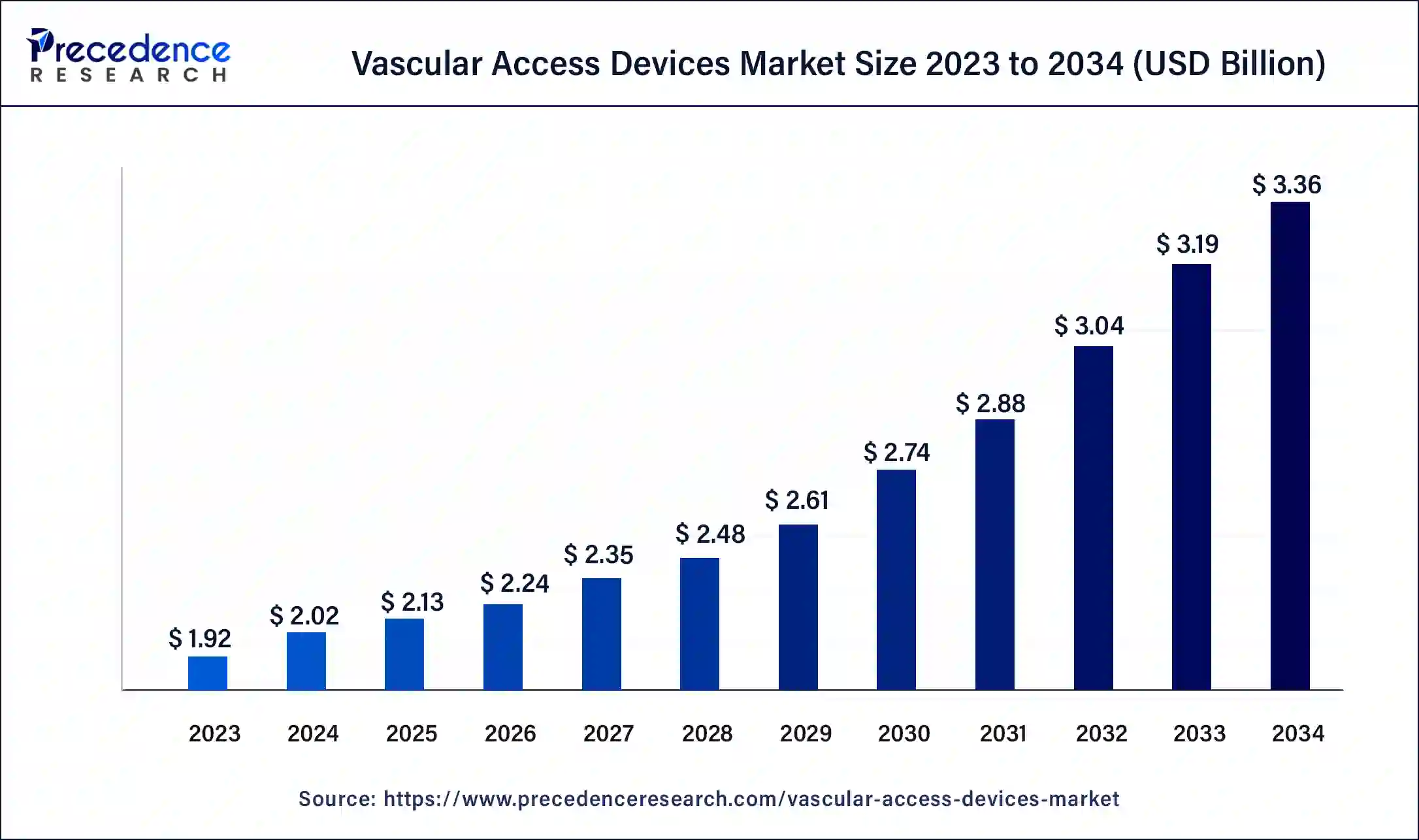
Vascular Access Devices Market Key Takeaways
- In terms of revenue, the vascular access devices market is valued at $2.13 billion in 2025.
- It is projected to reach $3.36 billion by 2034.
- The vascular access devices market is expected to grow at a CAGR of 5.22% from 2025 to 2034.
- North America dominated the vascular access devices market with the largest market share of 59% in 2024.
- Asia Pacific is expected to have the fastest growth in the market during the forecast period.
- By product type, the short peripheral intravenous catheter segment has generated the biggest market share of 42% in 2024.
- By end-use, the hospital-based segment has contributed the biggest market share of 51% in 2024.
How can AI Impact the Vascular access devices market?
AI helps transform the healthcare and pharmaceutical sectors by enabling cutting-edge technological advancements in healthcare infrastructure. Artificial intelligence plays an important role in vascular access for minimizing the high-morbidity, ruptures, and ESRD in patients with hemodialysis. AI devices allow the examination and grade of aneurysms in both arteriovenous and arteriovenous fistula grafts. Furthermore, the development of AI-enabled intervention devices that are used in emergency vascular access boosts the adoption of AI in vascular access devices.
AI in vascular access devices is a robotic catheterization tool that is portable and easy to use. It includes three main components: portable ultrasound devices that are connected to smart devices, smartphones, or tablets. The real-time software application that is connected to the ultrasound device helps in detecting required blood vessels. The robotic system identifies the blood vessel as a dot and allows physicians to inject the needle and guidewire placements.
- In January 2023, Viz.ai, a leading player in AI-powered disease detection and intelligent care coordination, launched the VizTM Vascular Suite, an AI-enabled software that allows vascular care teams to automatically identify and care for suspected right heart strain, pulmonary embolism, abdominal aortic aneurysm (AAA), and aortic dissection.
U.S. Vascular Access Devices Market Size and Growth 2025 to 2034
The U.S. vascular access devices market size was exhibited at USD 890 million in 2024 and is projected to be worth around USD 1.51 billion by 2034, poised to grow at a CAGR of 5.36% from 2025 to 2034.
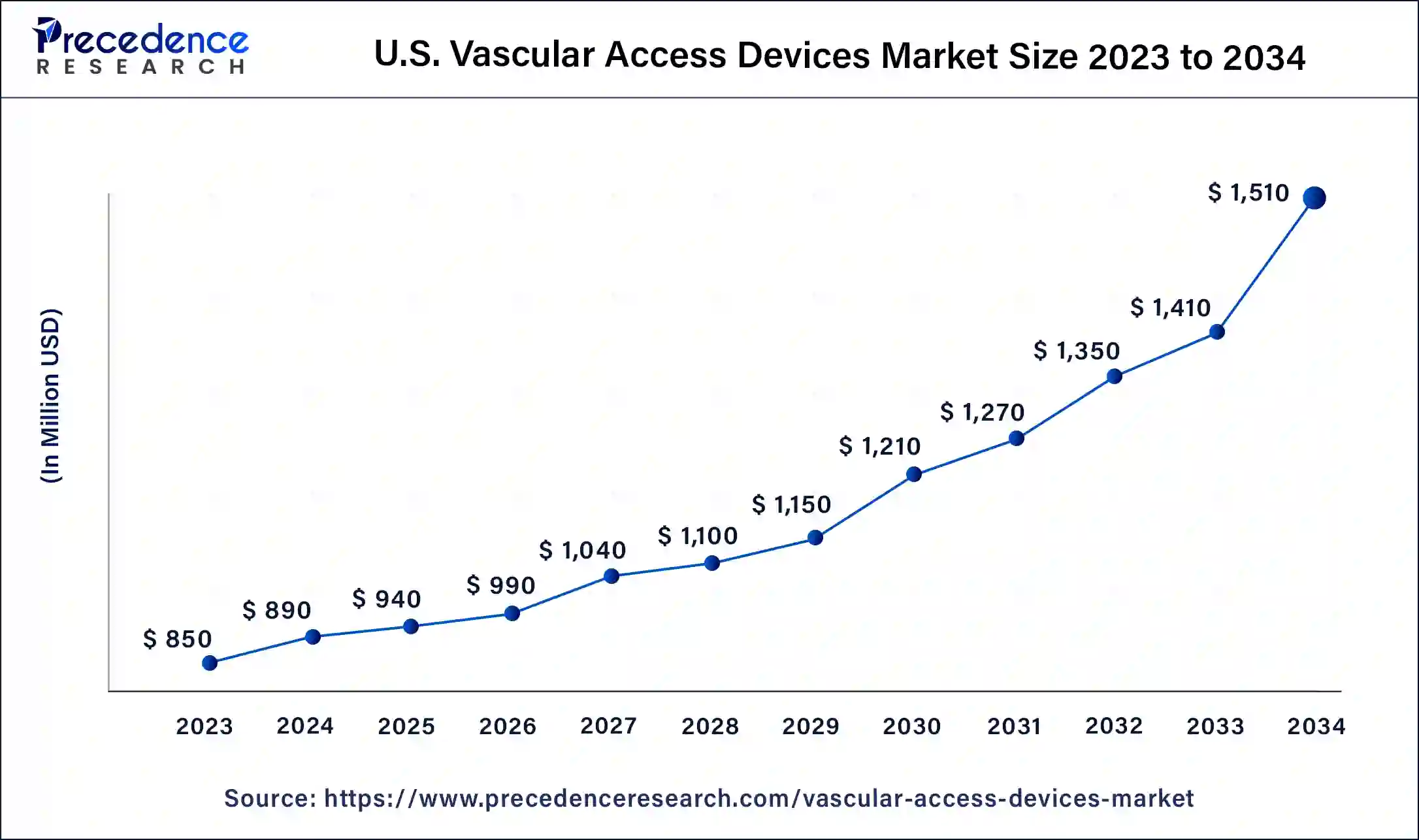
North America dominated the vascular access devices market with the largest market share in 2024. The growth of the market is attributed to the rising healthcare infrastructure and the increasing penetration of chronic disorders such as cardiovascular disease, cancer, diabetes, and others that drive the demand for vascular access devices. Additionally, the supporting government initiatives and investments regarding innovations in medical devices and infrastructural development in the healthcare and pharmaceutical industry are driving the growth of the vascular access devices market across the region.
- As per the National Health Expenditure Account (NHEA), healthcare spending by the United States will increase by 4.1%, reaching $4.5 trillion or $13,493 per person in 2022. With the sharing of the nation's Gross Domestic Product, healthcare spending accounted for 17.3%.
- The National Health Expenditure Account (NHEA) is the official agency responsible for estimating total healthcare spending in the United States. It estimates the total cost of healthcare spending, such as public health activities, healthcare goods and services, government administration, investment related to healthcare, and government administration.
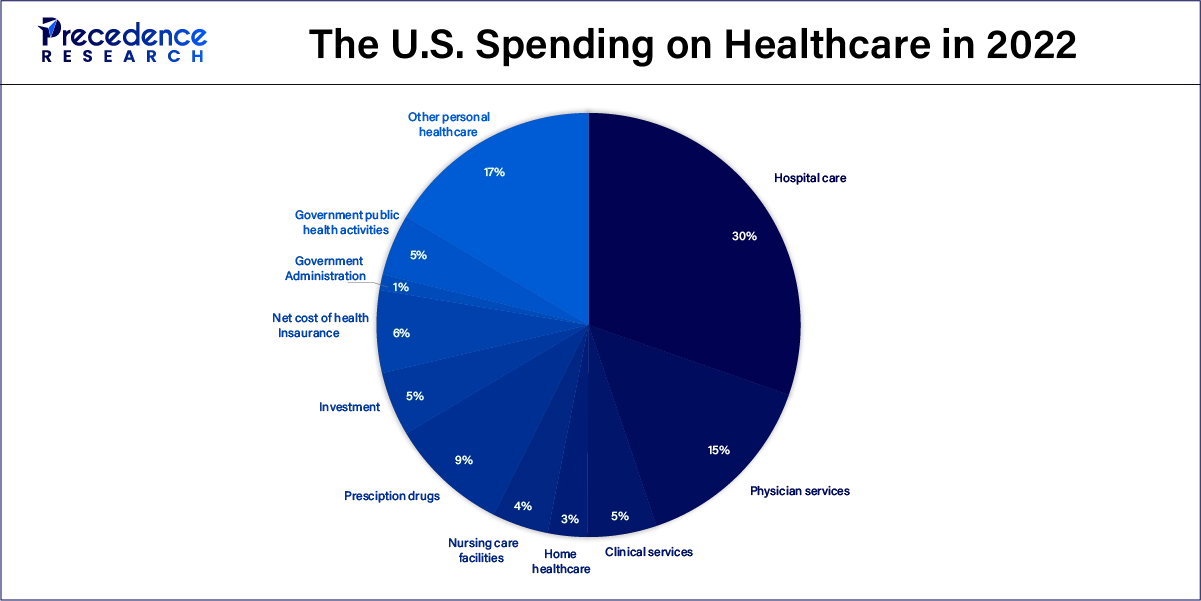
The U.S. healthcare spending is $4,464.4 billion in 2022. Hospital care accounted for the largest portion of the total, and physician services emerged as the second largest category in healthcare spending.
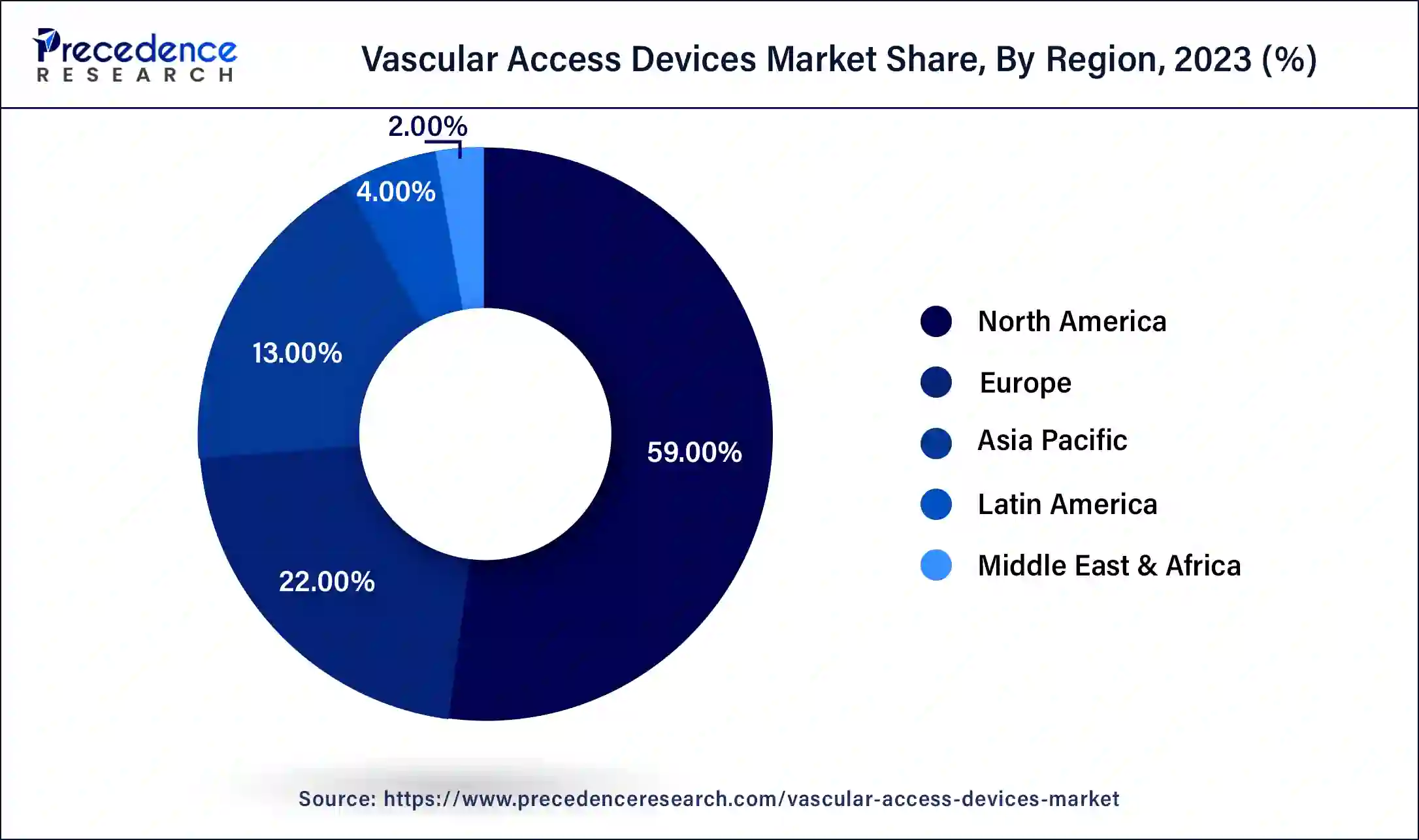
Asia Pacific is expected to have the fastest growth in the market during the forecast period. The growth of the market is owing to the rising population and the increasing demand for efficient healthcare infrastructure, which drives the growth of the market. The rising geriatric population that is more likely to get affected by chronic disease conditions like heart disease, cancer, high blood pressure, diabetes, and others is driving the growth of the vascular access devices market in the region.
- In October 2023, B. Braun Medical Inc. launched its new Introcan Safety 2 IV Catheter with Multi-Access Blood Control. The Introcan Safety 2 IV Catheter is the latest development in passive needlestick prevention catheters. Together with automatic needlestick protection, clinicians are also protected from blood exposure by reducing the risk of bloodborne pathogens throughout the IV process.
Europe is seen to grow at a notable rate in the foreseeable future in the vascular access devices market, stemming from an increasing aging population, a strong healthcare infrastructure, and a high prevalence of chronic diseases. These conditions often require long-term medical treatment, necessitating the use of vascular access devices for medication delivery, fluid management, and other procedures. The growing demand for outpatient procedures and home healthcare further contributes to the market expansion.
Market Overview
The vascular access device is one of the important components in the treatment of patients with chronic disease. The vascular access devices are used for the administration of liquid, fluid medications, and blood directly into the veins. It allows the monitoring of the hemodynamic functions used in the collection of blood specimens and in the dialysis process.
Vascular access devices are also used in the treatment of infectious diseases, including local infections, urinary tract infractions (UTIs), and bloodstream infections (BSIs) that can cause major health issues and sometimes mortality. There are some types of vascular access devices, including intravascular devices inserted in the peripheral veins, peripheral arterial devices, central nervous catheters, peripheral intravenous catheters (PIVC), peripherally inserted central catheters (PICC lines), and others. The rising number of medical emergency cases is driving the growth of the vascular access devices market.
Vascular Access Devices Market Growth Factors
- The increase in the global population and the rise in the geriatric population that is more likely to be affected by chronic disease drives the number of hospitals and healthcare institutes that drive the demand for the vascular access devices market.
- The increasing prevalence of chronic diseases such as cardiovascular disease, cancer, metabolism infection, UTIs, respiratory disease, and others are driving the growth of the vascular access devices market.
- The rising healthcare and pharmaceutical sectors, as well as the development and advancements in treatment and medicines, contribute to the growth of the market.
- The rising government initiative in the development of the healthcare and pharmaceutical infrastructure and further ongoing investment in the launch of healthcare devices boost the growth of the vascular access devices market.
- The increase in medical emergencies such as cardiac arrest, accidental cases, and others is driving the demand for the market. Further research and development programs in medical device innovations and launches are also driving the growth of the vascular access devices market.
Vascular Access Devices Market Trends
- In February 2024, part of Johnson & Johnson's MedTech “CERENOVUS, Inc.” launched the CEREGLIDE™ 71 Intermediate Catheter; it is the cutting-edge solution for the catheters with TruCourse™ directed for the revascularization of patients suffering from the acute ischemic stroke.
- In June 2024, Observe Medical ASA ("the Company" or "Observe Medical") announced the entrance of a Letter of Intent (LOI) with Sulacare AS ("Sulacare") for the partnering for the commercial launch of Sulacare's innovative and proprietary female catheterization product.
Market Scope
| Report Coverage | Details |
| Market Size by 2034 | USD 3.36 Billion |
| Market Size in 2025 | USD 2.13 Billion |
| Market Size in 2024 | USD 2.02 Billion |
| Market Growth Rate from 2025 to 2034 | CAGR of 5.22% |
| Largest Market | North America |
| Base Year | 2024 |
| Forecast Period | 2025 to 2034 |
| Segments Covered | Product, End-Use, and Regions |
| Regions Covered | North America, Europe, Asia-Pacific, Latin America, and Middle East & Africa |
Market Dynamics
Drivers
The increasing demand for hemodialysis
The increasing prevalence of chronic kidney disorders in the global population due to the aging factor, changing lifestyle preferences, and rising consumption of unhealthy food, alcohol, smoking, and other junk products are driving the cases of kidney-related diseases like kidney failures and others. The rising economies and the rising living standards due to the increase in disposable income drive the growth in unhealthy lifestyles, sleeping, and eating habits are some of the leading causes of the rising cases of kidney failure that drive the demand for hemodialysis for the frequent and regular treatment for the disease.
Vascular access is important in the dialysis process; it is the access point where the dialysis machine connects to the bloodstream. Artery vein fistula, catheters, and artery vein grafts are the three main types of vascular access devices that are used in hemodialysis. In which the artery vein fistula is known as the best vascular access device for hemodialysis. Thus, the rising cases of kidney disease and the prevalence of hemodialysis treatment drive the growth of the vascular access devices market.
- There are about 2 million patients worldwide affected by kidney disease or failure, of which 750,000 patients are affected in the United States per year. More than 100,000 patients in the United States are on the kidney transplant list, with the increasing demand for kidney donors in the United States at 8% per year.
- The average cost of hemodialysis in the Medicare system is $90,000 per patient annually in the United States, which is a total of $28 billion.
Restraint
High cost
The increased cost associated with vascular access devices due to technological advancements in medical devices and further improvements in healthcare devices are restraining the growth of the vascular access devices market.
Opportunity
Technological advancement in the vascular access device
The ongoing investment in the healthcare and pharmaceutical infrastructure for the development of new treatment procedures and medicinal usage boosts the growth of vascular access devices. Additionally, the rising investment in major technological advancements in vascular access devices boosts the growth opportunity in the vascular access devices market.
- The FDA approved two new devices for the prevention of the dysfunction, including Ellipsys, developed by Medtronic; it is a single catheter electrocautery device that is placed under the ultrasound. WavelinQ from BD is the dual catheter device placed under the fluoroscopy.
- The reimplementation of surgical technique and radial artery deviation, Laminate Medical developed the VasQ device that helps in supporting the additional support the patient's vasculature to limit the risk of arteriovenous fistula failure and Alio Smartwatch for the remote monitoring of patients of AV access flow surveillance.
Product Type Insights
The short peripheral intravenous catheter segment dominated the market with the largest vascular access devices market share in 2024. The increasing adoption of short peripheral intravenous catheters in hospitals for medicinal purposes boosts the growth of the segment. It is mainly used in the administration of medicinal fluids and blood products. It is the plastic tube inserted into the vein using a needle. The increasing penetration of chronic diseases in the population and the increasing number of hospitalized patients are driving the demand for the short peripheral intravenous catheter market.
End-Use Insights
The hospital-based segment held the largest share of the vascular access devices market in 2024. The growth of the segment is attributed to the rising investment in the healthcare infrastructure, which is driving the growth of the hospital segment.
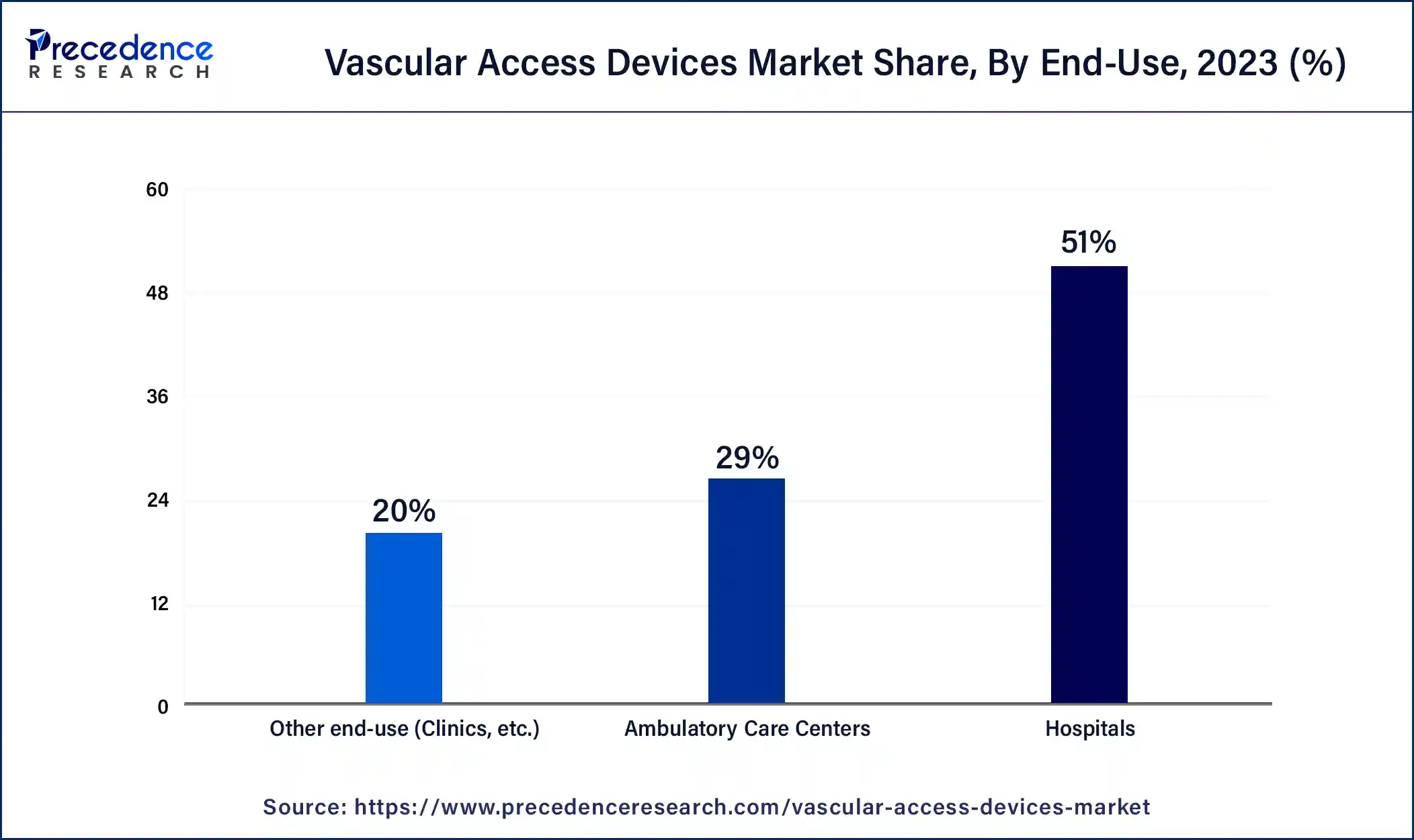
The rising emergence of hospitals for the treatment and surgical procedures for a number of diseases. The higher availability of skilled healthcare professionals and advanced medical devices boosts the growth of the segment.
Vascular Access Devices Market Companies
- Teleflex Medical
- BD
- B. Braun
- Smith's Medical (ICU Medical, Inc)
- Cook Medical
- AngioDynamics
- Medtronic
- Medical Components, Inc.
- Cook Medical
- Terumo Medical Corporation
- Access Vascular, Inc.
Recent Developments
- In June 2024, Tom Polen, chairman, chief executive officer and president of BD (Becton, Dickinson and Company) and Edwards Lifesciences, announced a definitive agreement under which BD will acquire Critical Care product group of Edwards for USD 4.2 billion by opening new avenues for growth and value creation opportunities and improving portfolio of BD smart connected care solutions.
- In November 2024, BD announced its launch of the BD Intraosseous (IO) vascular access system, designed to offer rapid vascular access during critical emergencies. This device is capable of the swift delivery of fluids or medication through the bone marrow cavity when traditional intravenous access is challenging. The BD IO System addresses both adult and pediatric patients by promoting unique capabilities for diverse anatomical necessities.
- In November 2023, BD, the globally recognized medical technology company, launched the advanced ultrasound system that is specifically designed to enhance clinical efficiency at the central venous catheters, peripherally inserted central catheters (PICCs), IV lines, and other vascular access devices.
- In June 2024, Royal Philips, a leading healthcare technology announced its first implant of the Duo Venous Stent System; it is an implantable medical device designed to treat symptomatic venous outflow obstruction in chronic venous insufficiency (CVI) patients with the approval of the U.S. Food and Drug Association (FDA).
- In December 2023, Becton, Dickinson Company (BD) launched the SiteRite 9 Ultrasound System in the market of the United States. The system got the approval of 510 (k) clearance in September and was extended as part of the company's vascular access management portfolio.
- In June 2024, Haemonetics, a medical technology company, announced the launch of VASCADE MVP XL, in addition to its existing portfolio of vascular closure devices with limited market access.
Segments Covered in the Report
By Product
- Short Peripheral Intravenous Catheter (Short PIVCs)
- Safety
- Standard/ Conventional
- Huber Needles
- Safety
- Standard/ Conventional
- Midline Catheters
- Standard
- Power-Injectable
- Peripherally Inserted Central Catheters (PICCs)
- Standard
- Power-Injectable
- Central Venous Catheters (CVCs)
- Acute
- Tunneled
- Dialysis Catheters
- Acute
- Tunneled
- Implantable Ports
- Single-Lumen
- Dual-Lumen
By End-Use
- Hospitals
- Ambulatory Care Centers
- Other End-use (Clinics, etc.)
By Region
- North America
- Asia Pacific
- Europe
- Latin America
- Middle East & Africa
For inquiries regarding discounts, bulk purchases, or customization requests, please contact us at sales@precedenceresearch.com
Frequently Asked Questions
Ask For Sample
No cookie-cutter, only authentic analysis – take the 1st step to become a Precedence Research client
 sales@precedenceresearch.com
sales@precedenceresearch.com
 +1 804 441 9344
+1 804 441 9344